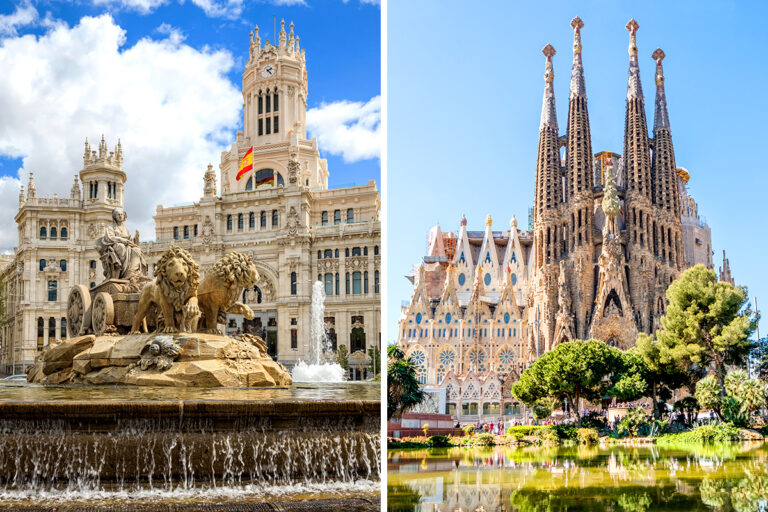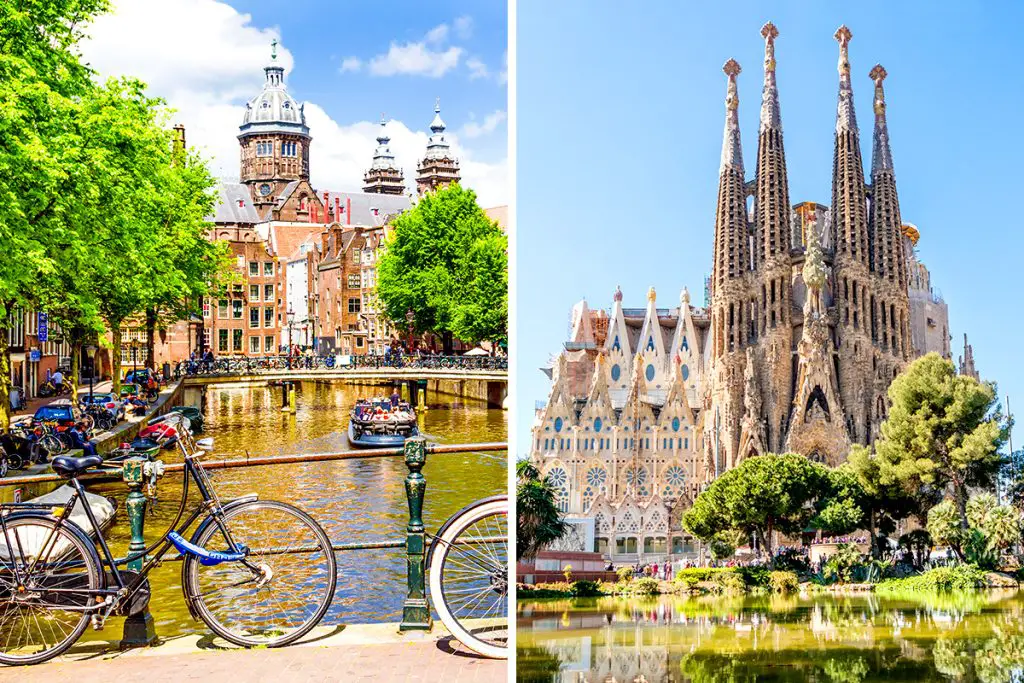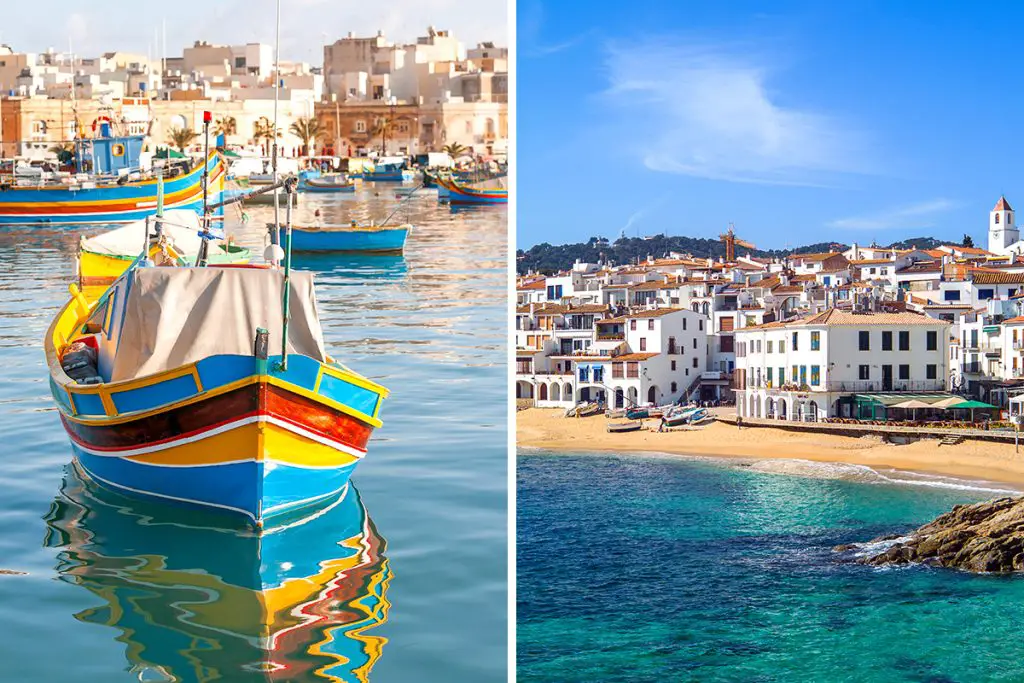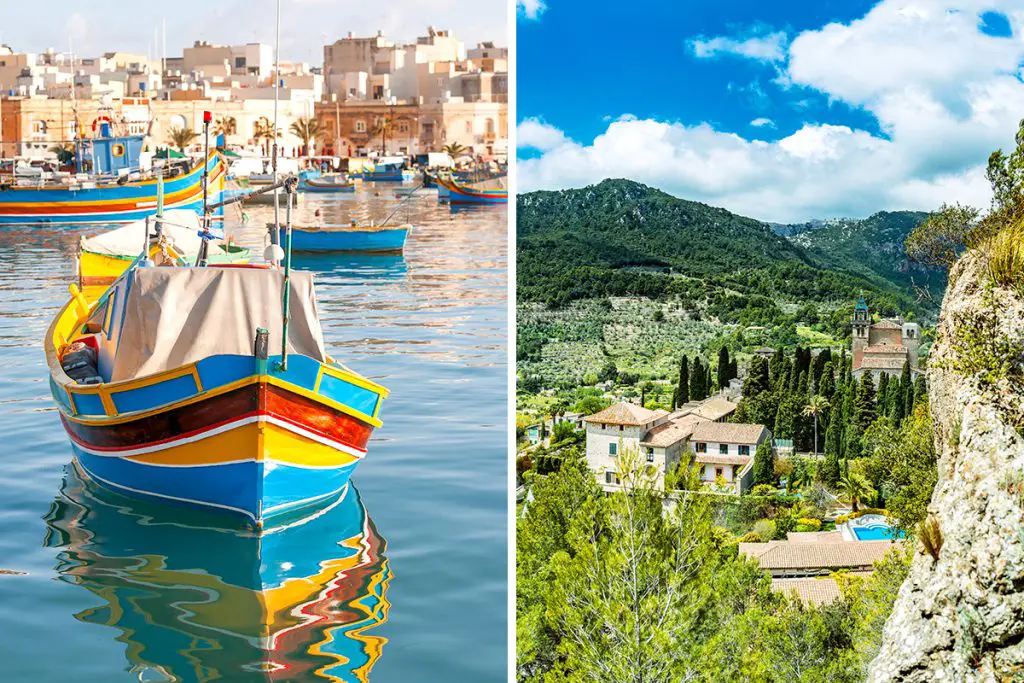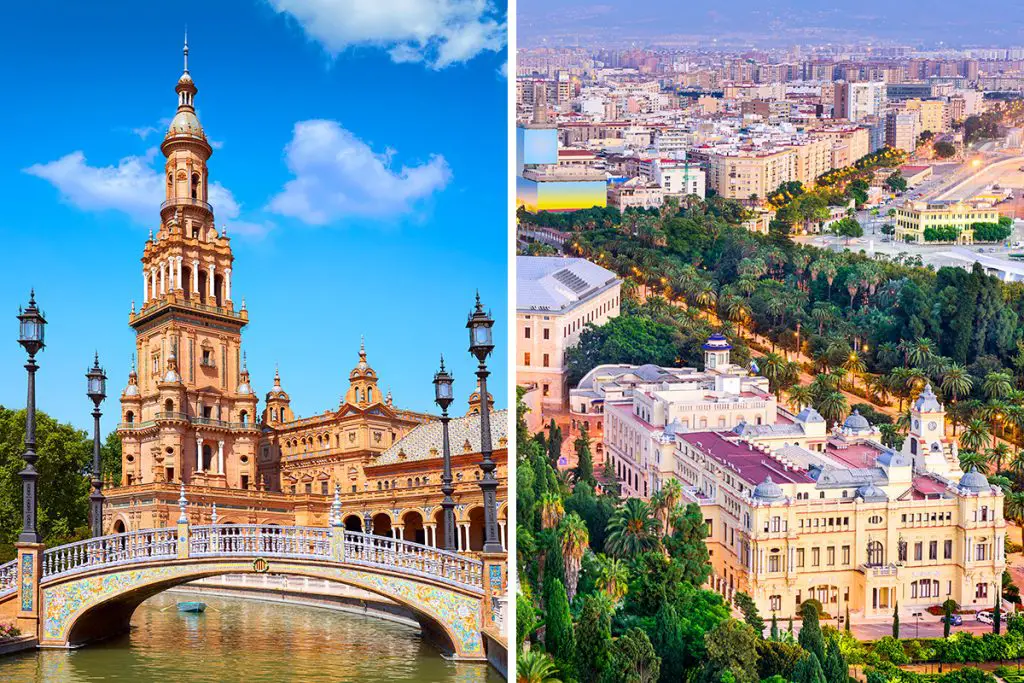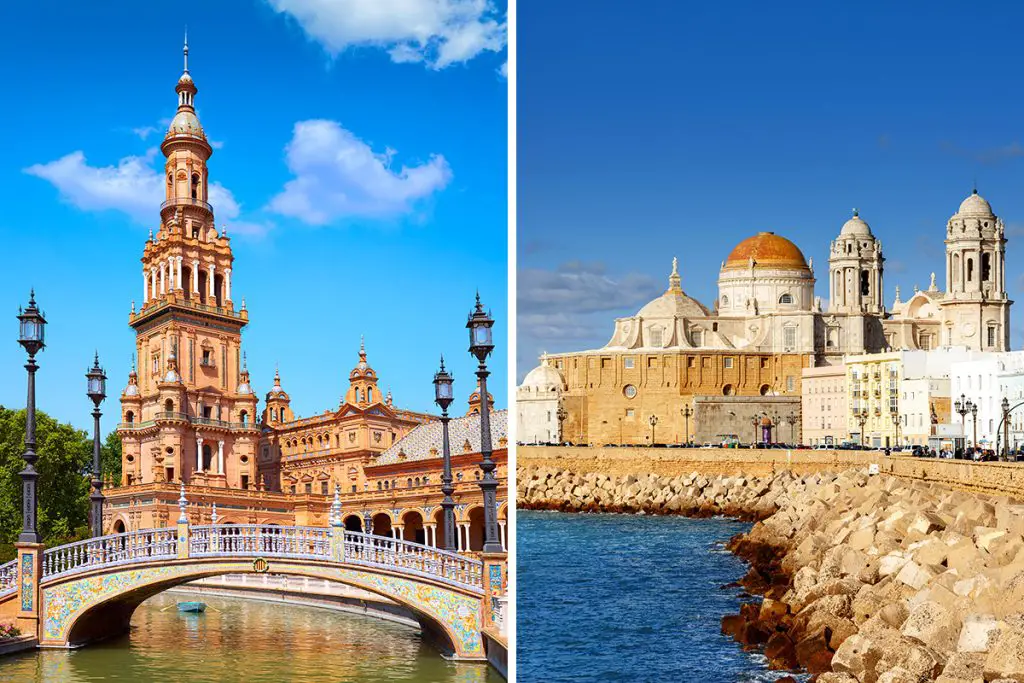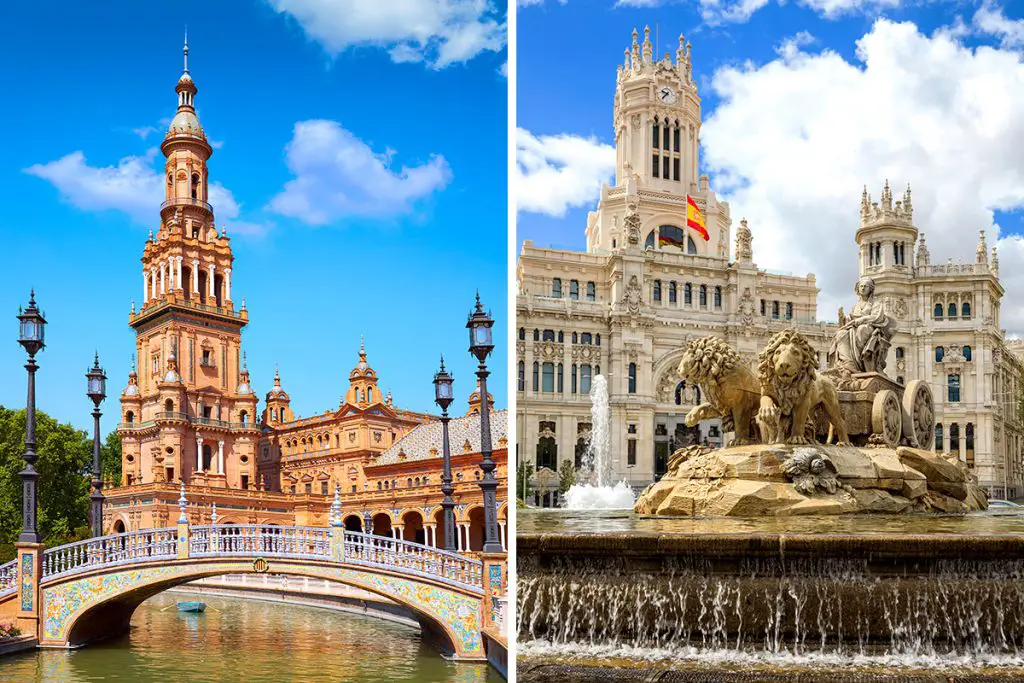Welcome to the ultimate Madrid vs. Barcelona showdown! Each city has its unique charm, and you might be wondering which one suits your travel preferences better. Keep reading as we compare these Spanish gems, and discover what makes each city a must-visit destination.
History & Culture
The history and culture of Madrid and Barcelona are as rich and diverse as the cities themselves. In this section, we’ll explore how the past has shaped the cultural landscape of these two remarkable destinations.
Madrid, Spain’s capital, has a storied history that dates back to the 9th century. Its role as the political and administrative center of the country has led to a fusion of regional cultures, which can be seen in the city’s art, architecture, and customs.
Throughout the centuries, Madrid has been influenced by various ruling dynasties, such as the Habsburgs and the Bourbons, who contributed to the city’s artistic and architectural legacy. Today, Madrid remains a hub for traditional Spanish culture, with its numerous museums, galleries, and plazas that showcase the country’s rich heritage.
In contrast, Barcelona’s history is closely tied to the broader history of Catalonia, a region with its own distinct culture and identity. Founded as a Roman city in the 1st century BC, Barcelona has been shaped by various cultural influences, including the Visigoths, Moors, and the Aragonese Crown.
The city’s unique blend of Spanish and Catalan culture is evident in its Modernist architecture, language, and customs. Barcelona’s identity as a creative powerhouse is also evident in its thriving arts scene, which encompasses everything from cutting-edge contemporary art to traditional Catalan folk performances.
While both Madrid and Barcelona are steeped in history, their cultural identities have been shaped by different forces. Madrid’s heritage is rooted in a blend of regional Spanish influences, whereas Barcelona’s culture is deeply connected to Catalonia’s unique history and traditions. As a result, visitors to these cities will find a fascinating mix of historical and cultural experiences that cater to a wide range of interests.
Whether you’re captivated by Madrid’s classical elegance or drawn to Barcelona’s innovative spirit, both cities offer a treasure trove of historical and cultural delights for travelers to explore and enjoy.
Attractions and Activities
When it comes to attractions and activities, Madrid and Barcelona are two cities that will never leave you bored. With a wealth of fascinating sights and experiences, let’s compare what each city has to offer in this regard.
Madrid is a city that beckons visitors with its artistic masterpieces and stunning architecture. As the heart of Spain’s Golden Age, Madrid is home to the Prado Museum, which features a world-class collection of European art, including works by Velázquez, Goya, and El Greco. History buffs can explore the Royal Palace of Madrid, a magnificent structure that showcases the opulence of the Spanish monarchy.
For a more leisurely experience, the expansive Retiro Park is an oasis in the city where you can enjoy a peaceful stroll, rent a rowboat, or simply admire the beautiful gardens and monuments.
Culturally, Madrid is known for its flamenco scene, and there are numerous tablaos (flamenco venues) where you can experience an authentic performance. Sports enthusiasts won’t want to miss a visit to the Santiago Bernabéu Stadium, home to the Real Madrid football team, where you can catch a match or take a behind-the-scenes tour.
Barcelona, on the other hand, is renowned for its striking Modernist architecture, most notably the works of Antoni Gaudí. Must-see attractions include the awe-inspiring Sagrada Família, the colorful Park Güell, and the elegant Casa Batlló.
The city also boasts a wealth of museums, such as the Picasso Museum, which houses an impressive collection of the artist’s early works, and the Fundació Joan Miró, dedicated to the avant-garde creations of this Catalan artist.
For outdoor enthusiasts, Barcelona offers an array of activities, from cycling tours that take you through the picturesque streets to exploring the scenic trails of Collserola Park, which overlooks the city. Additionally, the city’s rich history can be discovered by wandering through the charming Gothic Quarter, where narrow, winding streets reveal ancient churches, hidden squares, and historic monuments.
In summary, both Madrid and Barcelona provide a plethora of attractions and activities that cater to a wide range of interests.
While Madrid offers a more traditional Spanish experience through its art, history, and flamenco, Barcelona captivates visitors with its unique architecture, museums, and outdoor pursuits. Regardless of your preferences, both cities promise unforgettable experiences that will leave a lasting impression.
Eating, Drinking & Nightlife
Spain is famous for its vibrant culinary scene and lively nightlife, and both Madrid and Barcelona offer a delightful array of gastronomic experiences and nighttime entertainment. Let’s explore the differences and similarities between these two cities when it comes to eating, drinking, and nightlife.
Madrid is a haven for food lovers, with a wide variety of traditional Spanish and international cuisine available throughout the city. Tapas bars are a quintessential part of the Madrid experience, where you can sample bite-sized dishes like patatas bravas, jamón ibérico, and croquetas while enjoying a glass of wine or beer.
The city is also known for its historic food markets, such as Mercado San Miguel, where you can find fresh produce and artisanal products, as well as indulge in gourmet tapas and other culinary delights.
When it comes to nightlife, Madrid is famous for its late-night revelry, with many bars and clubs staying open until the early hours of the morning. The city’s diverse nightlife scene includes everything from cozy taverns and live music venues to energetic dance clubs, ensuring there’s something for everyone.
Barcelona, on the other hand, offers a unique culinary experience that combines Spanish and Catalan flavors. The city is renowned for its creative tapas bars and innovative restaurants, where you can savor dishes like escalivada, fideuà, and calcots.
For a taste of local Catalan cuisine, be sure to visit La Boqueria Market, an iconic food market located off La Rambla, where you’ll find a colorful array of fresh produce, seafood, and gourmet treats.
The nightlife in Barcelona is equally vibrant and varied, with options ranging from laid-back wine bars and traditional flamenco shows to pulsating nightclubs that play a mix of electronic, indie, and international music. The city’s nightlife is often centered around distinct neighborhoods, such as El Raval, El Born, and El Poble-sec, each offering a unique atmosphere and selection of venues to explore.
In conclusion, both Madrid and Barcelona are a feast for the senses when it comes to eating, drinking, and nightlife. While Madrid provides a more traditional Spanish experience, Barcelona offers a distinct Catalan twist on gastronomy and entertainment. No matter which city you choose, you’re sure to be delighted by the rich culinary culture and vibrant nightlife that await you.
Shopping
Shopping is an essential part of any travel experience, and both Madrid and Barcelona offer a wealth of options for shopaholics. In this section, we’ll compare the shopping experiences in these two vibrant cities.
In Madrid, shoppers can find a mix of high-end boutiques, international brands, and local artisanal shops. The city’s main shopping district, Salamanca, is home to luxury retailers like Chanel, Gucci, and Louis Vuitton, as well as Spanish designers like Loewe and Manolo Blahnik.
For a more traditional Spanish shopping experience, you can explore the charming streets of Malasaña and Chueca, where you’ll find independent boutiques, vintage stores, and quirky shops selling unique clothing, accessories, and souvenirs.
Madrid is also known for its bustling markets, such as El Rastro, an open-air flea market that takes place every Sunday. Here, you can browse through a variety of antiques, secondhand clothing, and handmade crafts, all while enjoying the lively atmosphere and street entertainment.
Barcelona, on the other hand, is a shopper’s paradise with its diverse array of shopping options.
The city is famous for its Modernist architecture, and this artistic influence extends to its fashion scene, with many local designers showcasing their unique creations in stylish boutiques throughout the city. Passeig de Gràcia, Barcelona’s main shopping avenue, is lined with upscale brands, chic fashion houses, and luxurious jewelry stores.
For a more eclectic shopping experience, the vibrant El Born neighborhood offers a mix of trendy boutiques, artisanal shops, and independent galleries. In addition, Barcelona’s markets, such as the Encants Market, provide a treasure trove of antiques, vintage clothing, and unique souvenirs, allowing you to immerse yourself in the city’s rich culture while hunting for one-of-a-kind finds.
In conclusion, both Madrid and Barcelona offer exceptional shopping experiences that cater to a variety of tastes and budgets. Whether you’re in search of luxury brands, local designs, or eclectic markets, these cities have something to offer every discerning shopper.
Accommodation
Finding the perfect place to stay is an important aspect of any trip, and both Madrid and Barcelona offer a wide range of accommodation options to suit all preferences and budgets. Let’s compare the lodging choices in these two captivating cities.
In Madrid, you’ll find a diverse selection of accommodations, from luxurious five-star hotels to budget-friendly hostels. Many of the city’s hotels are housed in historic buildings, offering a unique blend of old-world charm and modern amenities.
Areas like Gran Vía and Sol are popular for their central location, with easy access to Madrid’s main attractions, while quieter neighborhoods such as Chamberí and Retiro offer a more peaceful retreat.
Barcelona, on the other hand, boasts a variety of accommodation options that cater to different tastes and needs. The city is known for its stylish boutique hotels, many of which are situated in iconic Modernist buildings. For those on a budget, Barcelona offers a range of hostels and budget hotels, particularly in neighborhoods like El Raval and Poble-sec.
If you’re looking for a more authentic local experience, consider staying in a vacation rental or apartment in areas like El Born or Gràcia.
In summary, both Madrid and Barcelona provide an array of accommodation choices that cater to diverse preferences and budgets. Whether you’re seeking luxury, a budget-friendly option, or a local experience, you’ll find the perfect place to rest and recharge in these enchanting Spanish cities.
Family-Friendliness & Children’s Activities
Traveling with children can be a rewarding experience, and both Madrid and Barcelona offer a variety of family-friendly attractions and activities that cater to young travelers. In this section, we’ll compare the options available in these two Spanish cities for families seeking fun and engaging experiences.
In Madrid, there are plenty of family-oriented activities and attractions that will keep children entertained. The city boasts numerous parks, such as the famous Retiro Park, where families can enjoy picnics, rent rowboats, or visit the Crystal Palace.
For a more educational experience, the National Museum of Natural Sciences and the Planetarium offer interactive exhibits and displays that will spark your child’s curiosity.
Madrid is also home to the Madrid Zoo Aquarium and the Faunia Nature Park, both of which provide opportunities to encounter a variety of animals and learn about their habitats.
When it comes to family-friendly entertainment, Madrid offers a range of options, from puppet shows at the Teatro de Títeres to live performances at the Teatro Real, which often features shows specially designed for young audiences.
Barcelona, on the other hand, offers an equally impressive array of attractions and activities that cater to families with children. The city’s iconic Park Güell is a colorful playground that will delight kids with its whimsical architecture and imaginative design. Families can also explore the interactive exhibits at the CosmoCaixa Science Museum or admire the underwater world at the Barcelona Aquarium.
Outdoor adventures abound in Barcelona, with options like the Tibidabo Amusement Park, which offers a range of rides and attractions with stunning views of the city, or the Barcelona Zoo, where children can learn about wildlife and conservation efforts.
For a more relaxed experience, the city’s parks, such as Ciutadella Park and the Labyrinth Park of Horta, provide ample space for play and exploration.
In conclusion, both Madrid and Barcelona are well-equipped to entertain and engage families with children. With a variety of attractions, activities, and educational experiences, these cities provide the perfect backdrop for unforgettable family adventures and lasting memories.
Getting There & Getting Around
Planning your journey and navigating a new city are important aspects of any trip, and both Madrid and Barcelona offer a range of transportation options to help you get there and get around. In this section, we’ll compare the ease of travel and transportation in these two Spanish cities.
When it comes to getting there, Madrid is well-connected by air, with the Adolfo Suárez Madrid-Barajas Airport serving as Spain’s main international hub. The airport offers direct flights to and from numerous destinations around the world, making it a convenient entry point for travelers.
High-speed trains, such as the AVE, also connect Madrid to other major Spanish cities and European destinations, while a network of buses and highways make it easily accessible by road.
Once you’ve arrived in Madrid, the city’s efficient public transportation system, which includes buses, trams, and an extensive metro network, makes getting around a breeze. Taxis and rideshare services are also readily available, and many of the city’s attractions are within walking distance of each other, making it an ideal destination for exploring on foot.
Barcelona, on the other hand, is served by the Barcelona El Prat Airport, which is the second largest airport in Spain. The airport offers flights to and from various international destinations, and high-speed trains, such as the AVE, provide convenient connections to Madrid and other cities. Barcelona is also connected to the rest of Spain and Europe via an extensive bus network and well-maintained highways.
Navigating Barcelona is easy, thanks to the city’s comprehensive public transportation system, which includes buses, trams, and a metro network. The city also offers a bike-sharing program, Bicing, which is a popular and eco-friendly way to explore the city’s sights. Taxis and rideshare services are readily available, and many of the city’s attractions are within walking distance, making it a pedestrian-friendly destination.
In summary, both Madrid and Barcelona are well-connected and easily accessible, offering a range of transportation options for getting there and getting around. Whether you prefer exploring by foot, bike, or public transportation, you’ll find that navigating these vibrant cities is a seamless and enjoyable experience.
Weather
The weather can play a crucial role in shaping your travel experience, and both Madrid and Barcelona offer distinct climates that may influence your choice of destination. In this section, we’ll compare the typical weather conditions you can expect in these two Spanish cities.
Madrid, located in central Spain, experiences a Mediterranean climate with hot, dry summers and mild, wet winters. Summer temperatures in Madrid can reach highs of around 86°F (30°C) during the day, while winter temperatures can drop to lows of around 37°F (3°C) at night. The city enjoys plenty of sunshine throughout the year, with occasional rainfall occurring mostly in the fall and spring months.
In contrast, Barcelona, situated on the northeastern coast of Spain, enjoys a Mediterranean climate with mild, humid winters and warm, sunny summers. Due to its coastal location, Barcelona’s weather is generally more temperate than Madrid’s, with summer temperatures reaching highs of around 82°F (28°C) and winter temperatures rarely dropping below 41°F (5°C).
The city also sees more rainfall than Madrid, particularly during the fall and spring months, although its overall climate is still considered mild and pleasant.
In conclusion, while both Madrid and Barcelona enjoy Mediterranean climates, their specific weather conditions differ due to their geographic locations. Madrid tends to have hotter summers and cooler winters, while Barcelona experiences more moderate temperatures and higher humidity levels throughout the year.
Depending on your personal preferences and planned activities, you may find one city’s weather more appealing than the other.
Safety
When planning a trip, safety is an important consideration for many travelers. In this section, we’ll compare the general safety levels of Madrid and Barcelona, two of Spain’s most popular cities.
Both Madrid and Barcelona are considered safe cities for tourists, with low levels of violent crime. However, like in any major city, petty crime such as pickpocketing and theft can be an issue in crowded areas and popular tourist spots. In this regard, Madrid and Barcelona are quite similar, and travelers should exercise caution and take common-sense precautions to safeguard their belongings.
Overall, Madrid and Barcelona offer a safe and welcoming environment for visitors. By staying vigilant and following standard safety practices, you can enjoy your trip with peace of mind in either city.
Cost
Budget is often an important factor when planning a trip, and comparing the cost of visiting Madrid and Barcelona can help you make an informed decision. In this section, we’ll take a look at the general costs associated with traveling to these two popular Spanish cities.
In terms of accommodation, both Madrid and Barcelona offer a range of options to suit various budgets, from luxury hotels to affordable hostels. However, Madrid tends to be slightly more affordable than Barcelona, with average hotel prices around €100 (approx. $110) per night compared to Barcelona’s €120 (approx. $132) per night.
When it comes to dining out, both cities offer a mix of high-end restaurants and budget-friendly eateries. On average, a meal at a mid-range restaurant in Madrid might cost you around €25 (approx. $28) per person, while in Barcelona, you can expect to pay slightly more at €30 (approx. $33) per person. Bear in mind that prices can vary depending on the area and type of cuisine.
Public transportation costs are similar in both cities, with a single metro or bus ticket in Madrid costing €1.50 (approx. $1.65) and in Barcelona €2.20 (approx. $2.42). Taxis and rideshare services are also available in both cities, with prices varying based on distance and time of day.
In conclusion, while both Madrid and Barcelona offer a range of budget options, Madrid is generally considered to be slightly more affordable overall. However, with careful planning and research, you can find ways to enjoy either city without breaking the bank.
Which Is Better – Madrid or Barcelona?
In this article, we’ve explored and compared various aspects of Madrid and Barcelona, two of Spain’s most popular destinations. While both cities have their own unique charm and appeal, your decision to visit one over the other may depend on your personal preferences and priorities. Let’s recap our findings and consider when one city might be a better choice than the other.
In terms of history and culture, both cities are rich in heritage, but Madrid, as the capital, boasts a more regal atmosphere, with its palaces and grand boulevards. Barcelona, on the other hand, is renowned for its modernist architecture, particularly the works of Antoni Gaudí, and its vibrant art scene.
When it comes to attractions and activities, both cities offer a wide range of options for all interests. Madrid is home to world-class museums and parks, while Barcelona’s unique architecture and seaside location provide a distinctive experience. If you’re looking for a more diverse array of attractions, Barcelona may be the better choice, while Madrid may appeal more to those with a penchant for history and art.
For foodies and nightlife enthusiasts, both Madrid and Barcelona have plenty to offer, with their tapas culture and lively after-dark scenes. Barcelona may be the better choice for seafood lovers, while Madrid’s culinary scene tends to be more traditional. If you’re looking for a more cosmopolitan atmosphere, Barcelona’s nightlife scene may be more appealing.
Shopping-wise, both cities provide a mix of high-end boutiques, local markets, and popular stores. However, Barcelona’s shopping scene is generally considered more diverse and contemporary, with a focus on cutting-edge design and fashion.
In terms of family-friendliness, both cities cater well to children, offering a variety of attractions, activities, and accommodations that are suitable for young travelers. Your choice here may come down to the specific interests of your children and the kind of experiences you want them to have.
Considering weather, Madrid experiences more extreme temperatures, with hotter summers and colder winters, while Barcelona’s coastal location offers a more moderate climate. If you prefer milder temperatures, Barcelona might be the better option.
Regarding safety, both cities are generally safe for tourists, although petty crime can be an issue in crowded areas. Exercising caution and taking standard precautions apply to both destinations.
Finally, Madrid is generally considered to be more affordable than Barcelona in terms of accommodation, dining, and attractions. If budget is a major concern, Madrid may be the better option.
In conclusion, there is no definitive answer as to which city is better – Madrid or Barcelona. The best choice for your trip will depend on your individual interests, preferences, and priorities. Both cities offer unforgettable experiences, and you may even find that visiting both during your Spanish adventure is the best way to experience all that Spain has to offer.

